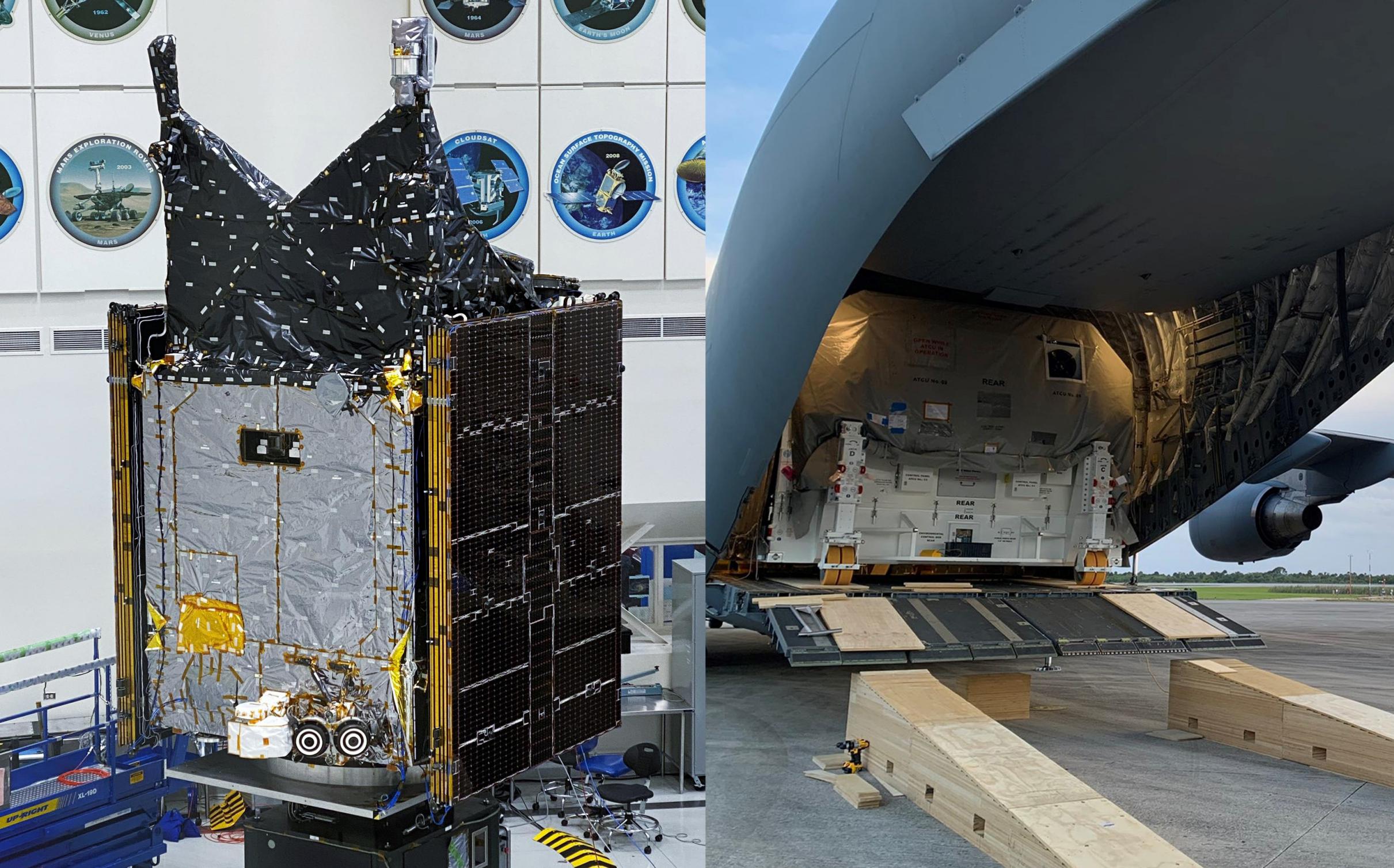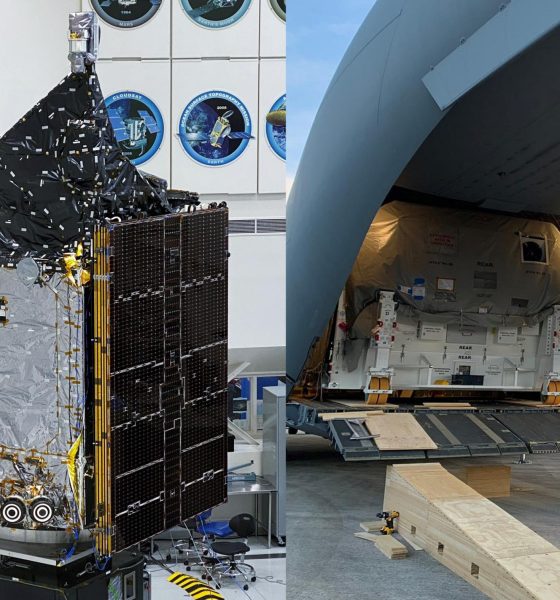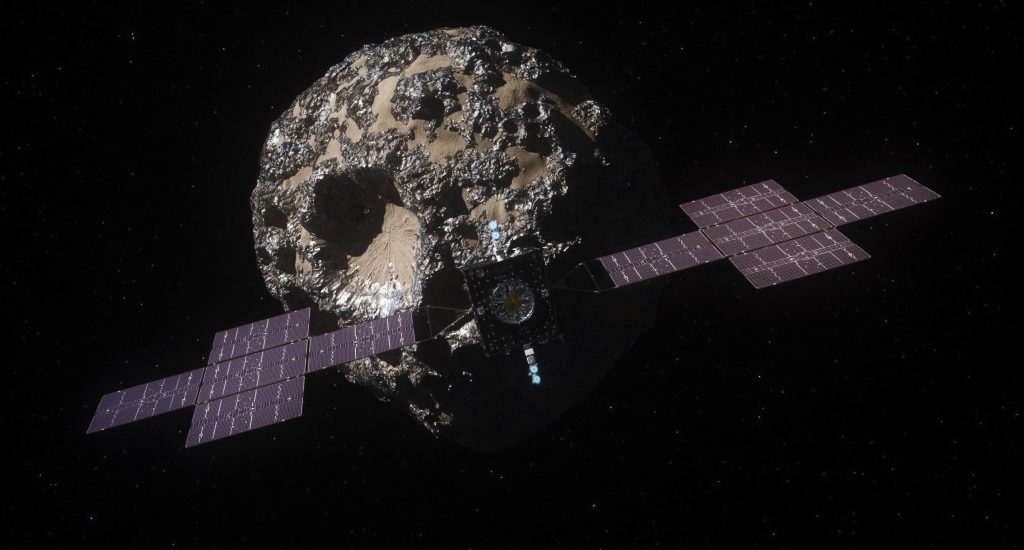

News
SpaceX Falcon Heavy payload arrives in Florida for the first time in years
For the first time in almost three years, a spacecraft meant to launch on SpaceX’s Falcon Heavy rocket has arrived in Cape Canaveral, Florida and begun to prepare for flight.
Known as Psyche, the scientific mission is designed to venture hundreds of millions of miles from Earth to explore a namesake asteroid that’s believed to be almost entirely metallic. Psyche will also mark NASA’s first operational use of Falcon Heavy, which offers performance far superior to other existing and soon-to-be-retired rockets and at a fraction of their cost.
However, even though Psyche is now the first payload (officially confirmed) to have arrived in Florida for a Falcon Heavy launch since May or June 2019, that doesn’t guarantee that it will be first to launch.

That uncertainty is the result of multiple chronically delayed US military payloads that were both supposed to launch on different Falcon Heavy rockets as early as late 2020. In June 2018, just four months after Falcon Heavy’s iconic launch debut, the US military purchased its first operational launch on the rocket. Known as AFSPC-52 and later renamed USSF-52 after the US government cobbled together a few loosely-related military groups and rebadged them as the “Space Force,” the mission was expected to launch as early as September 2020. In February 2019, the military announced that another Falcon Heavy rocket had been chosen to launch AFSPC-44 (USSF-44) as early as late 2020 or early 2021.
About a year ago, for unknown reasons, USSF-44 took USSF-52’s place as the US military’s first operational Falcon Heavy launch. Now, between three and four years after their initial launch targets, USSF-44 is scheduled to launch NET late June 2022 (a delay of ~18 months) and USSF-52 is set to follow as soon as October 2022 (a delay of ~25 months).
On April 29th, NASA’s Launch Service Program (LSP) revealed that the ~2600-kilogram (~5700 lb) Psyche spacecraft had completed the journey from the Jet Propulsion Laboratory’s (JPL) Pasadena, California assembly facilities to Kennedy Space Center, Florida. After several years of work spent designing, manufacturing, and assembling Psyche, the spacecraft ultimately arrived at on time, leaving it on track to launch on Falcon Heavy as early as August 1st, 2022.
At the moment, that makes Psyche’s launch far more likely to happen before USSF-44, which has repeatedly gotten within a few months of a purported launch target before the US military acknowledged additional delays. Like USSF-44, Psyche’s Falcon Heavy rocket – three boosters, an upper stage, and a fairing – will be entirely new. Due to the high performance required for each mission and the fact that both will be the first operational use of the rocket for NASA and the USSF, each brand-new Falcon Heavy center core will be intentionally expended.
If it launches more or less on time, USSF-44 will be SpaceX and Falcon Heavy’s first direct launch to geostationary orbit (GEO), requiring the rocket’s upper stage to survive a roughly six-hour-long coast and perform a lengthy orbit circularization burn around ~42,500 kilometers (~26,400 mi) above Earth’s surface. With a payload that weighs around four tons (~8800 lb), it’s little surprise that Falcon Heavy’s center core will be expended. Psyche, on the other hand, is headed into deep space on a trajectory that NASA’s own ELVPerf calculator – supplied with official performance data from SpaceX – says Falcon Heavy can launch more than four tons (~8800 lb) to while still recovering all three boosters. It’s unclear why NASA would need a 50-70% safety margin.
Regardless, the second half of 2022 could be quite the spectacle of Falcon Heavy launches after a more than three-year hiatus. On top of USSF-44, Psyche, and USSF-52, Falcon Heavy is tentatively scheduled to launch a ViaSat-3 communications satellite directly to GEO in Q3 2022 and, even more tentatively, the Space Force’s USSF-67 mission in November 2022.

Elon Musk
SpaceX issues statement on Starship V3 Booster 18 anomaly
The incident unfolded during gas-system pressure testing at the company’s Massey facility in Starbase, Texas.

SpaceX has issued an initial statement about Starship Booster 18’s anomaly early Friday. The incident unfolded during gas-system pressure testing at the company’s Massey facility in Starbase, Texas.
SpaceX’s initial comment
As per SpaceX in a post on its official account on social media platform X, Booster 18 was undergoing gas system pressure tests when the anomaly happened. Despite the nature of the incident, the company emphasized that no propellant was loaded, no engines were installed, and personnel were kept at a safe distance from the booster, resulting in zero injuries.
“Booster 18 suffered an anomaly during gas system pressure testing that we were conducting in advance of structural proof testing. No propellant was on the vehicle, and engines were not yet installed. The teams need time to investigate before we are confident of the cause. No one was injured as we maintain a safe distance for personnel during this type of testing. The site remains clear and we are working plans to safely reenter the site,” SpaceX wrote in its post on X.
Incident and aftermath
Livestream footage from LabPadre showed Booster 18’s lower half crumpling around the liquid oxygen tank area at approximately 4:04 a.m. CT. Subsequent images posted by on-site observers revealed extensive deformation across the booster’s lower structure. Needless to say, spaceflight observers have noted that Booster 18 would likely be a complete loss due to its anomaly.
Booster 18 had rolled out only a day earlier and was one of the first vehicles in the Starship V3 program. The V3 series incorporates structural reinforcements and reliability upgrades intended to prepare Starship for rapid-reuse testing and eventual tower-catch operations. Elon Musk has been optimistic about Starship V3, previously noting on X that the spacecraft might be able to complete initial missions to Mars.
Investor's Corner
Tesla analyst maintains $500 PT, says FSD drives better than humans now
The team also met with Tesla leaders for more than an hour to discuss autonomy, chip development, and upcoming deployment plans.

Tesla (NASDAQ:TSLA) received fresh support from Piper Sandler this week after analysts toured the Fremont Factory and tested the company’s latest Full Self-Driving software. The firm reaffirmed its $500 price target, stating that FSD V14 delivered a notably smooth robotaxi demonstration and may already perform at levels comparable to, if not better than, average human drivers.
The team also met with Tesla leaders for more than an hour to discuss autonomy, chip development, and upcoming deployment plans.
Analysts highlight autonomy progress
During more than 75 minutes of focused discussions, analysts reportedly focused on FSD v14’s updates. Piper Sandler’s team pointed to meaningful strides in perception, object handling, and overall ride smoothness during the robotaxi demo.
The visit also included discussions on updates to Tesla’s in-house chip initiatives, its Optimus program, and the growth of the company’s battery storage business. Analysts noted that Tesla continues refining cost structures and capital expenditure expectations, which are key elements in future margin recovery, as noted in a Yahoo Finance report.
Analyst Alexander Potter noted that “we think FSD is a truly impressive product that is (probably) already better at driving than the average American.” This conclusion was strengthened by what he described as a “flawless robotaxi ride to the hotel.”
Street targets diverge on TSLA
While Piper Sandler stands by its $500 target, it is not the highest estimate on the Street. Wedbush, for one, has a $600 per share price target for TSLA stock.
Other institutions have also weighed in on TSLA stock as of late. HSBC reiterated a Reduce rating with a $131 target, citing a gap between earnings fundamentals and the company’s market value. By contrast, TD Cowen maintained a Buy rating and a $509 target, pointing to strong autonomous driving demonstrations in Austin and the pace of software-driven improvements.
Stifel analysts also lifted their price target for Tesla to $508 per share over the company’s ongoing robotaxi and FSD programs.
Elon Musk
SpaceX Starship Version 3 booster crumples in early testing
Photos of the incident’s aftermath suggest that Booster 18 will likely be retired.

SpaceX’s new Starship first-stage booster, Booster 18, suffered major damage early Friday during its first round of testing in Starbase, Texas, just one day after rolling out of the factory.
Based on videos of the incident, the lower section of the rocket booster appeared to crumple during a pressurization test. Photos of the incident’s aftermath suggest that Booster 18 will likely be retired.
Booster test failure
SpaceX began structural and propellant-system verification tests on Booster 18 Thursday night at the Massey’s Test Site, only a few miles from Starbase’s production facilities, as noted in an Ars Technica report. At 4:04 a.m. CT on Friday, a livestream from LabPadre Space captured the booster’s lower half experiencing a sudden destructive event around its liquid oxygen tank section. Post-incident images, shared on X by @StarshipGazer, showed notable deformation in the booster’s lower structure.
Neither SpaceX nor Elon Musk had commented as of Friday morning, but the vehicle’s condition suggests it is likely a complete loss. This is quite unfortunate, as Booster 18 is already part of the Starship V3 program, which includes design fixes and upgrades intended to improve reliability. While SpaceX maintains a rather rapid Starship production line in Starbase, Booster 18 was generally expected to validate the improvements implemented in the V3 program.
Tight deadlines
SpaceX needs Starship boosters and upper stages to begin demonstrating rapid reuse, tower catches, and early operational Starlink missions over the next two years. More critically, NASA’s Artemis program depends on an on-orbit refueling test in the second half of 2026, a requirement for the vehicle’s expected crewed lunar landing around 2028.
While SpaceX is known for diagnosing failures quickly and returning to testing at unmatched speed, losing the newest-generation booster at the very start of its campaign highlights the immense challenge involved in scaling Starship into a reliable, high-cadence launch system. SpaceX, however, is known for getting things done quickly, so it would not be a surprise if the company manages to figure out what happened to Booster 18 in the near future.








